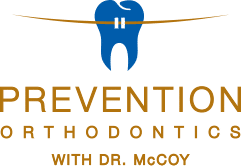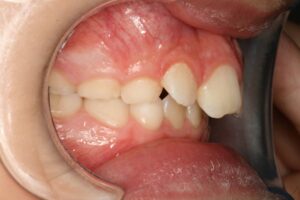By age 7, my child should already have visited an Orthodontist
What? Isn’t that too early?
The American Association of Orthodontists (the AAO) recommends that by age 7 children should be seen BY AN ORTHODONTIST AND NOT BY YOUR DENTIST.
Why should my child be evaluated by an Orthodontist by age 7?
Ask yourself one simple question:
Is it better to have to fix something that’s been allowed by your dentist to get complicated or is it better to never let that something get so complicated in the first place?
Why did the dentist let this 8 year old’s front teeth erupt so far beyond the level of the other teeth?
Is this the way we want people’s teeth to look when they’re older?
All of their back teeth are at one level and the upper front teeth just kept growing downward. And the dentist just let it happen!
Wouldn’t it have been better to have prevented this problem BEFORE it was just allowed to happen?
No braces, just careful monitoring and perhaps an at-home removable appliance that gently and naturally guides your teeth into better alignment.
Wouldn’t it have been better to simply stop the eruption of the front teeth at the right time, as they erupted, rather than have to push teeth back up through bone to where they already were?
Can’t my dentist monitor my child?
Dentists wait and then send patients too late.
The later you wait (past age 6) to see an orthodontist, the longer your teenage child will need to wear braces because more complicated movements will be needed that could have been prevented.
Your general dentist had only two classes on orthodontics way back in dental school.
I used to do fillings back in dental school, but there is no way you would want me to do a filling on you or your child, now. It’s been decades since I learned that!
Some dentists know more than others, but very few dentists know a lot about jaw growth and development. They routinely let the time pass to prevent the development of tooth problems. They do the same for jaw growth problems, which are even harder to diagnose because even orthodontists miss them.
Dr. McCoy has seen countless dentists, and even a bunch of orthodontists, completely miss the diagnosis of a developing jaw problem. They tell the parents that they can wait to begin orthodontic treatment, even up to age 14.
By that age, our ability to correct a jaw problem is greatly diminished. Think of redirecting a boulder that is rolling down a hill versus pushing a boulder that isn’t already moving. Guiding and redirecting jaw and tooth growth is vastly simpler in a growing child. Preventing that jaw problem from even occurring in the first place is even better!
Your child’s permanent teeth start coming in at age 6. First grade is the first time they should be seen by an orthodontist for a free appointment and some photographs. We then put them on six month recall, like your dentist does for their cleanings, but we are monitoring your child’s growth and development – something your dentist was not trained to do.
Preventing tooth problems from getting so complicated is certainly the way to go.
Not enough dentists know what to look for as their young patients develop. They were not trained adequately in this. It’s not their fault. It’s the fault of the dental schools. So go ask an orthodontist about your 1st grader’s erupting teeth, not your dentist.
More importantly:
Not enough dentists know how vital it is to prevent bad growth and tooth movements from happening.
That is the most important sentence on this page. Please read it again.
- Preventing what normally happens to most patients by the time they are 8 or 9 is essential:
- See your child when they are in kindergarten. Yes, kindergarten. They have teeth, don’t they? How are they developing from an ORTHODONTIST’S point of view, looking towards the future. If you think kindergarten, then at least you’ll get them in to an orthodontist by 1st grade. We’re all busy people, after all.
- Your child’s new teeth start erupting at age 6.
- Let an expert monitor this, not a dentist.
- Prevent the over-eruption of their front permanent teeth so they don’t develop a deep bite compared to where their back teeth bite together.
- Prevention is essential for ending up with an easy orthodontic case to correct at age 12 or 13, a correction that will remain more stable long-term!
- Not preventing what normally happens to your young child even by age 8 or 9 takes what later could have been a simple orthodontic case and has already allowed it to become a problem that is difficult to correct. Plus, the correction of complicated cases is much more difficult to maintain long-term. Prevention builds in stability.
Here is what your general dentist may or may not know, but what you MUST know:
Dentists and patients think their wisdom teeth make their teeth crooked at around age 18, despite having had braces a few years earlier. Here is why that’s not true:
- Your child’s muscles and underlying bones are establishing the level of their bite from at least age 5 or 6 onwards. That’s why the AAO says to see an orthodontist by age 7 (which means you need to go to an orthodontist at age 6, not 7).
- The bite I’m talking about is the posterior bite level, the level at which the upper and lower back teeth meet, not how the front teeth meet.
- Your child’s front teeth usually don’t meet at this same bite level.
- Most of the time, your child’s permanent front teeth have been allowed by your dentist to over-erupt way past the bite level of their back teeth, already leading to a deep bite by the time they are age 8 or 9.
- It is vastly better for long-term stability if the front teeth had never been allowed to over-erupt, only to have to try and push them back up where they came from. Does having to push teeth back up where they came from make sense or does not letting them over-erupt in the first place make better sense?
- On patients who didn’t get the benefit of prevention orthodontics, we straighten their deep bite later with clear aligners or braces within about two years of treatment. But, your child had that deep bite since around age 6, certainly by age 8.
- We changed what they had been doing for years and years with orthodontic treatment in a short period of time.
- So, their bite gradually returns to the level your dentist let develop, the level that their muscles and jaw pattern and tongue position dictated and remember.
- This relapse of the deep bite happens just a few years after orthodontic treatment, which just so happens to be around the time people’s wisdom teeth start to erupt.
- Bingo! It must be that the wisdom teeth caused the return of the crowding.
- No, that has been disproven with many studies. Wisdom teeth do NOT PUSH.
- Your child’s teeth are simply going back towards where your dentist watched them over-erupt if they did not send you to an orthodontist BEFORE age 7 so problems can be prevented.
Why isn’t your dentist sending you to an orthodontist before age 7, as recommended by the AAO, to prevent these problems from ever developing?
- Good question. I have no idea.
- I blame the schooling and I blame the lack of outreach to dentists by the AAO.
- When your child turns 6, every single dentist should be automatically providing you with a referral to an orthodontist, telling you that the AAO recommends an evaluation by an orthodontist NOW and stressing to you the PREVENTION NOW IS BETTER THAN INTERVENTION LATER.
- But, unfortunately, Dr. McCoy sees far too many dentists just let your child’s teeth get worse and worse from age 6 to age 12 and only then send you to the orthodontist.
- Your child has been developing a jaw discrepancy or a deep bite for years, and your dentist just let it happen!
We need to correct dentist’s and parent’s thoughts on when to see an orthodontist.
- We are talking about being seen by an orthodontist at age 6. No, your child is not going into braces at age 6.
- Your child needs to be examined by an orthodontist at around age 6.
- We are talking about PREVENTING problems from getting difficult to correct starting at age 6, the age that your child’s new teeth start erupting.
- Look at your child’s birthday. If they turn age 7, call the orthodontist yourself because they already should have been evaluated! We take photos and you go home.
- Even if your dentist says you can wait, you need to understand that dentists are usually wrong about that. Look at that picture up above again. That child is only 8 and their dentist just let their front teeth keep on growing instead of stopping them at their proper height.
- The AAO recommends that you be evaluated by an orthodontist, not by your dentist. Why are dentists going against what the AAO recommends? Dentists simply don’t know that going to a specialist in growth and development and letting the specialist monitor and guide your child’s growth and development to PREVENT DRASTIC ORTHODONTIC PROBLEMS makes much more sense.
- Dr. McCoy has been told by patients that their dentists tell their patients, “your child has just lost their last baby tooth, so it’s time to see the orthodontist.” Nowhere in any dental book is it suggested that a child see an orthodontist at such a late date, the last baby tooth being lost at around age 13 or 14. Dentists made that arbitrary milestone up because they don’t know what they are looking at. They don’t know that they could have PREVENTED problems instead of allowing them to happen because your child still has baby teeth. What about the over-erupted permanent teeth that could have been halted at the proper level and never allowed to get bad?
- If your child is in 1st grade, that’s when they already should 1st see an orthodontist.
- If your child is in 2nd grade, you are 2 years late to see an orthodontist. If you are in 3rd grade…etc. Let all your family and friends know this simple rule of thumb. I know the math is incorrect, but it’s simpler to remember that way 🙂
- Only an orthodontist like Dr. McCoy who knows how simple and effective and stable it is to PREVENT orthodontic problems from developing in your 6 year old can help you.
- Almost all dentists wait to send you to an orthodontist until you’re in 7th grade, until glaring problems have been let happen!
- Please do what the AAO recommends and let’s work together with Dr. McCoy to, very simply, PREVENT orthodontic problems from getting complicated!
Make the free exam appointment at Dr. McCoy’s office at age 6 because you need to prevent front teeth from over-erupting, not fix it later!
- You need to encourage proper tongue positioning and breathing and jaw positioning while your child is growing, not when it’s too late by age 12!
- A very simple device is used at home, kind of like a football mouthguard, which will encourage your child’s jaws and muscles and teeth to develop in the best manner possible.
- Only later do we do full orthodontic treatment, but the stability is better and the treatment time is reduced because we prevented problems from becoming bad.
Can’t you just fix everything when my child is around 12?
- Braces at this late stage can correct your child’s deep bite.
- But, it is usually corrected by changing the bite level of the back teeth over the course of 18-24 months of treatment.
- Quickly changing the bite level that your body has established over many years isn’t stable.
- Your child’s muscles were used to the bite level that they had established for themselves since age 5 or 6 onwards.
- So, your child’s teeth gradually move back towards this bite level, bringing back the crowding and a deeper bite again.
- This usually happens by the time your child is 18 and people and dentists mistakenly blame wisdom teeth for the crowding, but we both know that’s not true!
So what should we do?
Your child has to be seen before they turn age 7 by an orthodontist like Dr. McCoy who understands how simple, early diagnosis and intervention, not extensive early treatment, can guide erupting teeth and jaws into a more favorable position, preserve space for permanent teeth, and reduce the likelihood of fracturing protruded front teeth.
Dr. McCoy can guide the growth and development of your child’s jaws and the prevent the position of their incoming permanent teeth from becoming unstable. Dr. McCoy looks at your child’s breathing pattern, tongue positioning, skeletal make up and how their teeth fit into their bite.
Early intervention can also regulate the width of the upper and lower dental arches, gain space for permanent teeth, avoid the need for permanent tooth extractions (which is a huge plus), correct thumb sucking and eliminate abnormal swallowing or speech problems.
In other words, early intervention will greatly simplify later treatment undertaken after all the permanent teeth erupt.
Does early treatment benefit all children?
Yes. Guiding your child’s teeth into the right positions and managing where they position their tongue and lower jaw and encouraging nose breathing , not mouth breathing, makes later treatment more predictable and stable.
What does Dr. McCoy do differently than other orthodontists for my child?
Dr. McCoy’s orthodontic supervisory program is ideally started at age 6 because that’s when your six-year molars erupt, your permanent molars that come in behind your baby teeth.
Dr. McCoy’s orthodontic supervisory program is for preventing your child’s teeth from getting really bad.
Most patients get a simple mouthguard-like device, a myofunctional device that they wear at home. We teach them some muscle and swallowing and breathing exercises to do at home, as well.
This myofunctional approach encourages an improved development of your child’s dental arches and jaws and teeth.
Dr. McCoy also monitors your child’s ongoing growth and development and determines the optimum time to later begin orthodontic treatment.
We enroll your children in our Patient Rewards Club so they can play some awesome, safe games online and also earn points towards getting themselves a gift card!
Dr. McCoy’s myofunctional intervention is about prevention and is the most affordable way to create a smile and bite that is in harmony with your child’s jaws and muscles.
If my child has early intervention, will this prevent the need for Clear Aligners or braces treatment as an adolescent?
Early intervention will prevent, or if started later, can begin to reverse the significant jaw and tooth and breathing problems that are not easily corrected over age 10 (at least not with as stable a result).
The goal of early monitoring by Dr. McCoy is to prevent more severe problems from developing and to simplify future treatment and to enhance long-term stability. You will need braces later but the treatment will be simpler and more stable.
Because all of the permanent teeth have not yet erupted when early treatment is performed, their initial alignment can be optimized, preventing the overeruption and crowding that normally occurs in many patients.
After early prevention, a shortened comprehensive phase of treatment will still be needed in the teen years after all the permanent teeth have erupted. Straight teeth have less bacteria of the bone-destroying kind, so your teeth become more healthy with braces or clear aligners like SureSmile and Invisalign.
The comprehensive phase is usually shortened because tooth positions and breathing and muscle and jaw patterns have all been optimized by Prevention Orthodontics with Dr. McCoy during your child’s development.
Your child will still need Invisalign or braces later, but the long-term stability of that work will be enhanced because your child’s jaws and teeth and muscles and breathing pattern will be in harmony with their teeth, as opposed to having an unstable final result later, that is not in harmony with established jaw and muscle patterns because your dentist and you did not know about the benefit of early intervention and prevention with Dr. McCoy.
Do we still need to see our family dentist during orthodontic intervention treatment?
Because we want to insure the highest level of dental health, we recommend that you see your family dentist for regular check-ups and cleanings every 6 months.
But leave the growth and development and prevention of dramatic orthodontic problems to Dr. McCoy, please!
We can’t expect your dentist to remember those two, short classes they had way back in dental school.
Let Dr. McCoy guide the growth and development of your child’s teeth and jaws and muscles and tongue and breathing so that all of these elements are in harmony when they are ready for comprehensive treatment.






